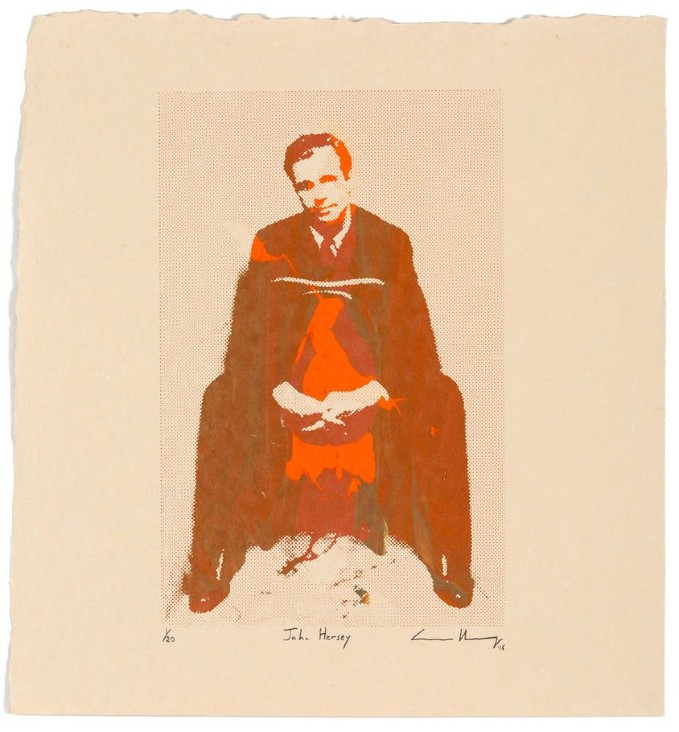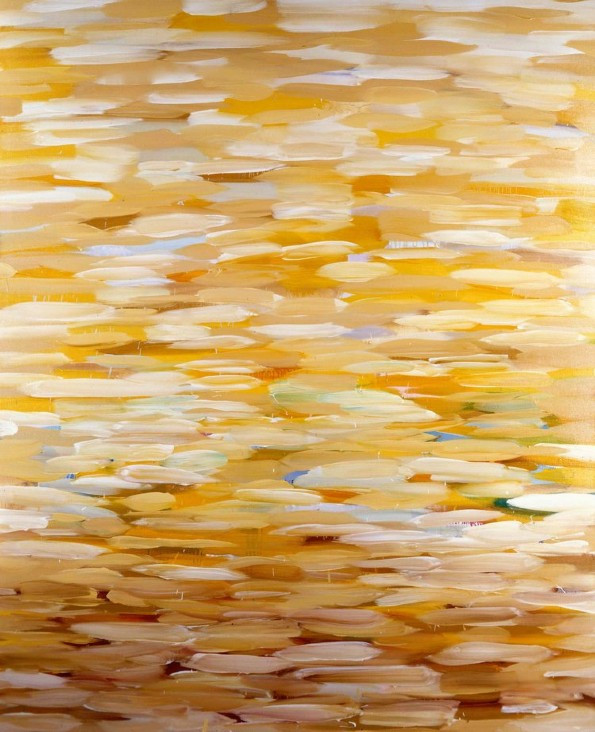Creativity, Three Generations Strong, At Carrie Chen Gallery
An exhibit focuses on the disparate output of the Hersey family — John, John Jr., and Cannon.

An exhibit focuses on the disparate output of the Hersey family — John, John Jr., and Cannon.

Cannon Hersey, "John Hersey, 2016," silkscreen on handmade banana leaf and cotton pulp paper, 12x18 inches
Is creativity inherited? The Meaning of Memory, an exhibition at Carrie Chen Gallery in Great Barrington (August 6 to September 22) addresses this question by focusing on three generations of the Hersey family, and in this case, the answer is yes —but it takes form in very different genres in this small group show with a twist.
Journalist John Hersey (1914-93) wrote “Hiroshima,” the acclaimed 1946 article in The New Yorker describing the bombing and its aftermath in graphic detail; it focuses on six survivors’ accounts from the morning of the explosion to one year later. The magazine had intended to run Hersey’s 31,000-word opus in four excerpts, instead running it in its entirety as one issue; its pleasant cover gave no clues about the terrors within. Two months later, Knopf published it as a book. It has sold over three million copies and remains a prime account of the horrors of nuclear war. Some of Hersey’s personal artifacts, including letters and books, will be on view at the gallery.
John Hersey Jr. (1943-2018) painted large abstractions which he referred to as “physical lyricism.” Carrie Chen, gallery owner and curator of the exhibition, describes his work as having “a light-filled energy, strong colorful brushstrokes, dappled surfaces.” Hersey, Jr. also opened Gallery Hirondelle in Soho, which attracted many artworld luminaries such as Peter Bradley, Andy Warhol, and Gerard Malanga.

Cannon Hersey, "Secret Language", 2015-16, silkscreen on South African Shweshwe textiles woven into a Hiroshima survivor's kimono
In turn, Hersey’s grandson, Cannon, has picked up the threads spun by his grandfather. He has visited Hiroshima roughly 30 times, speaking with survivors’ descendants and revisiting the devastation that his grandfather so eloquently recounted. He shows photographs, textiles, and silkscreens including haunting imagery of remnants of the blast. Working with the Hiroshima Peace Memorial Museum, Cannon has created virtual 3D images of bombed objects in a project called "Future Memory." He will receive the Scone Foundation’s annual archivist award in Copake on August 6, the eve of the 77th anniversary of the Hiroshima bombing.
So how are the three generations’ work connected, other than by family bloodlines? Chen notes, “The connection is clear between Cannon and John Sr.’s work, with Cannon continuing his grandfather's legacy of drawing attention to Hiroshima and its effects. John Jr.’s paintings are more personal in nature. But one similarity between John Jr. and his father is that throughout his lifetime, John Sr. faced considerable opposition to his journalism, especially his work on Hiroshima. He struggled to pursue his writing and elucidate hard truths in the face of censorship. This ethos of self-expression and creative freedom carries on in John Jr.’s abstract work.”
We are all products of our unique time on Earth, and the three Herseys reflect this. While the journalism that John pursued revolved around one of the most devastating acts man has inflicted, we are lucky that he persisted to record the bomb’s savagery so that ensuing generations knew of its destruction. It’s particularly salient at a moment when the world seeks energy sources other than fossil fuels, including nuclear power. John Jr. painted during a time in which art thrived in New York, manifesting in a robust gallery and social scene. And Cannon has looked outside of himself, back at his grandfather’s work, to find inspiration and revisit urgent issues. His use of silkscreening also echoes one favored by Warhol, one of his father’s acquaintances.
Chen says the juxtaposition of these three related artists’ work, “raises several interesting questions: what different forms does art take and how does medium shape creative message? How does an epoch shape artistic output? What is the meaning of artistic legacy?” "The Meaning of Memory" provides a fascinating lens through which to view these queries about the nature of art and creativity.


